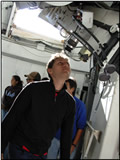
Joshua Irvine is about to enter his fourth year at the University of Hawai’i at Manoa in the Fall 2006 concentrating his studies in Bioengineering with a minor in Spanish language. He aspires to obtain a M.D./P.H.D after finishing his Masters degree in Bioengineering, at the University of Hawai’i at Manoa–but he is open to the option of attending graduate school at an international or US–mainland institution. He enjoys learning and loves to combine his passions of culture plus science to better aid our community. He hopes one day that his generation will leave a sustainable and lasting legacy which will not affect the needs of future generations.
Institution when accepted: University of Hawai’i at Manoa
Akamai Project: Wild Fowl Migration Pattern Analysis of Avian Influenza Outbreaks
Project Site: Pacific Disaster Center
Mentors: Chris Chiesa and Pam Cowher
Project Abstract:
Commonly known as “Bird Flu”, H5N1 Avian Influenza virus (AI) is a high pathogenic viral infection that infects the upper and lower respiratory system. The bird mortality rate of the disease is nearly 100 percent. AI is easily contracted when one comes in intimate contact with either infected surfaces or infected wild and/or domesticated fowl. The imminent threat of human-to-human transmission has heightened the need to track outbreaks. The scope of this project is to utilize Geographic Information Systems (GIS) technology to evaluate any correlation between migration patterns of wild fowl in Europe, Africa and Asia to emergent outbreaks of the virus. Incorporating time series interpolation animation onto maps will show if the presence of wild fowl in an infected region plays any significant role in avian outbreaks. Along with the maps, statistical analysis will be provided to confirm the significance of the findings. Ka wa ma hope, the time after, is a concept of future sense which governs the Hawaiians to look backwards in order to progress forward. Mirroring Hawaiian philosophy, the spatial visualizations provided in this study from past observations will later be used to predict future outbreak spreads.